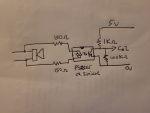Thinking on it a bit, some galvanic isolation may be needed. A simple opto-isolator will do the job easily.
The two 150R resistors limit the opto current to 10mA. There is one from each speaker connection to offer some protection to the amplifier against shorts in the add-on circuitry.
The opto-isolater shown is a dual-diode device, so it will generate twice the input frequency. Maybe better to use a single diode version.
The 100K resistor gives a solid pull-down when the opto is 'off'. The 1K resistor is a 5mA load for the opto.
This type of circuit should give a good signal to the Schmitt trigger on C.2, so then you just need to measure the frequency, which we will cover later.
As PieM suggested, a simple diode envelope detector is not going to be reliable with a Schmitt input, unless maybe you are running the Picaxe at 3V. Either way, I think the opto-isolator is a safer solution.


